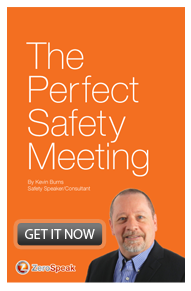There are many spectators at safety meetings but very few fans - and even fewer safety participants.

On a trip to Minneapolis, Minnesota last week, I attended a major league baseball game between the Minnesota Twins and the Seattle Mariners at Target Field - perhaps the most impressive ball park in North America. It was the ball game that made me think about the different levels of safety attitude and participation.
Thirty thousand fans attended the Saturday night game - ten thousand shy of the stadium’s maximum capacity. We arrived early so that we could catch batting practice, warm-ups, field grooming and even have a chance to walk the concourse - which have no barriers so even when standing in line for a beer or a hot dog, you can still watch the ball game from anywhere in the park. It is an impressive place.
The 20-1 Ratio
It takes 2,000 people to make a Minnesota Twins Major League ball game happen. I actually called the Minnesota Twins front office to ask that question. Between the vendors, ushers, ticket-takers, players, umpires, field staff, production and promotions people and the other assorted people who have a role in carrying off a ball game, they need 2,000 people.
So, if 2,000 people are required to make a ball game happen for 40,000 fans, that puts the ratio at 1-in-20: one participant for every twenty spectators. That seems to be about the same ratio for the vast majority of safety meetings. One person for every twenty will be involved with organizing, presenting at or contributing to a safety meeting.
“In sports, like life, there are those who play and then there are those who pay to watch those who play.” - Kevin Burns
At a safety meeting, there are more spectators than fans - and even fewer participants. Here is a look at the differences between the three. Figure out where you belong.
The Safety Participant
The Safety Participant is the guy who is heavily invested in making the safety program work. He prepares for safety meetings, volunteers to sit on the safety committee, and is the first one to help celebrate safety. Like a baseball player, the safety participant steps up to take a swing at the ball every day. Sometimes he misses. Sometimes he strikes out. But sometimes he hits home runs. And it doesn’t matter. He is not attached to the outcome. No, he is more inspired by stepping up to the plate, standing in the batters box of safety every day and swinging the bat. The safety participant isn’t afraid of being teased by his co-workers. He is not afraid to stick out from the crowd.
The Safety Fan
The Safety Fan is excited about cheering on the safety participants. He is very quick with a compliment when he sees someone else doing safety right. He gets excited by tracking the numbers and cheers the loudest when his team does well. And even when the team is down, he never loses hope that the team can turn it around. He takes notes at the safety meetings. He knows the rules, the procedures and processes. He can quote chapter and verse from the safety manual. His optimism for safety is infectious. Like a true baseball fan, he wears the team colors, tracks the stats, is very vocal is cheering the team on and is the first one to jump to his feet when there is something to cheer for. The safety fan will always support the safety participants.
The Safety Spectator
The Safety Spectator has little attachment to the safety program - unless there’s something in it for him. The safety spectator is an opportunist. He is the guy who sits back, arms crossed at the back of the room at safety meetings and simply watches. He is quick to point out what others are doing wrong and has an opinion on how to fix the safety program - but won’t lift a finger to do anything about it. He takes no notes. He will not invest himself. He remains cynical even when safety is going well. He waits for something to go wrong so that he can criticize it - from a distance. He has all of the answers if someone would just ask him. In his mind, safety is something he is forced to do.
There are many spectators at safety meetings but very few fans - and even fewer safety participants. Spectators don’t engage. At least fans do. Imagine how different your safety program would be if there were more fans and participants and fewer spectators.
For ideas on how to increase the numbers of fans and participants at safety meetings, download my free e-book, The Perfect Safety Meeting.



